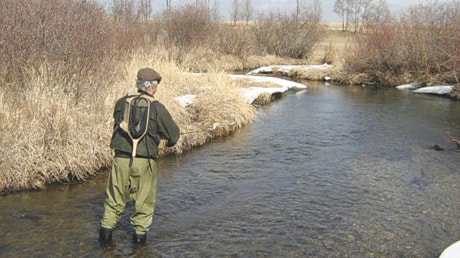Quickly into my year-end email extermination it becomes obvious that the theme this year has been the steady erosion in the provinces of the systems and laws intended to protect and preserve renewable natural resources: public land, including parks, water, fish and wildlife.
Most obvious symptom for outdoors people is when so many of them either ask, or try to answer this simple question: When was the last time you were checked by a fish and wildlife officer? In the past year, travelling in diverse parts of the province, I have seen only two officer’s trucks “on the hoof” in hunting and fishing country, while I have seen dozens parked, here and there in towns and cities.
The culprit, of course, is yet another massive cut to fish and wildlife division budgets, meaning there are fewer officers, period, and strict gas quotas mean there are almost none of them in the field. The result is that there have been far fewer wildlife and fisheries act violators caught, charged, and convicted than in the recent past, and the fish and wildlife resource is suffering.
Less noticeable, but more serious, is the steady erosion of any and all laws that, over the years, have proven effective in protecting the natural resources on which our fish and wildlife depend, their habitat, in a word.
Most recent and egregious example is Bill 29, The Alberta Parks Act, which would have seriously weakened protections for provincial parks, wilderness areas, ecological reserves and heritage sites and opened them up for all manner of destructive development.
The public outcry was so great that tourism, parks and recreation minister, Cindy Ady, withdrew the bill, promising to reintroduce it after public consultation. Why was it introduced without public consultation in the first place?
That was preceded by “Potatogate,” the scheme of the government to sell to a supporter, for a price that has never been disclosed, 16,000 acres of public land, priceless and scarce native prairie grassland, allegedly to grow potato chips. Again, massive public outrage, and the scheme is scrubbed.
A quieter but very pointed lesson in what is happening can be learned simply by outdoors persons, having witnessed some environmental atrocity, trying to get something done about it. Earlier this year I wrote a column about anglers sending me pictures and asking simply “what is going on here?” about a long stretch of Prairie Creek, just downstream from my Stump Ranch.
I still can’t answer the question, because neither the province, nor the county has said anything about whether county bylaws were being violated, or whether the 25-foot public reserve along the creek was being encroached on.
Workers for the Alberta Conservation Association did report to me that the Bucks for Wildlife stream-protecting fence had been torn out, but there was not much they could do about that, because “somebody” neglected to register a Caveat against the title.
Only the federal Department of Fisheries and Oceans contacted me and thanked me and my readers for bringing this matter to their attention.
DFO has been on the property many times and determined some damage had been done to fish habitat and the fishery and were happy to report that they had contacted the owner and secured his understanding and co-operation in repairing the damage.
All of which tends to confirm the private belief of even some Alberta government people that the only protector of the Alberta fishery and fish habitat is the federal DFO.
What is less well known is that it is the province that causes or permits the most damage, for example, to the Elbow River near Allen Bill Pond within the last two years and being ordered to pay huge fines and repair the damage after being convicted on charges brought by DFO, the feds.
A worse scandal is the damage to Alberta’s rivers and streams the Alberta government fosters and permits from cattle grazing and clear cutting too close to river and stream banks on grazing and logging leases on our public land.
The year-end irony is a notice I have just received from the ACA that, because of budget constraints, effective Jan. 1, 2011, they are terminating the agreement for the stream-protecting Bucks for Wildlife fence on my property on Prairie Creek.
The ACA is “very pleased with the positive impacts on the riparian habitat that resulted from the streambank fencing,” they say, “and hope you will continue riparian area management and protection.” Oh . . . and the responsibility to remove the Caveat from the title is mine.
So, we can’t afford an inexpensive, effective program for stream protection on private land and have never even bothered on public land.
But we endlessly endure a government that thinks it is so rich it can lavish our priceless public land on supporters and the plush, ruinously expensive pay, perks and pensions Alberta’s MLAs create for themselves, not to mention the “severance,” if and when we ever wise up and boot these clown princes out.
Bob Scammell is an award-winning writer living in Red Deer.
